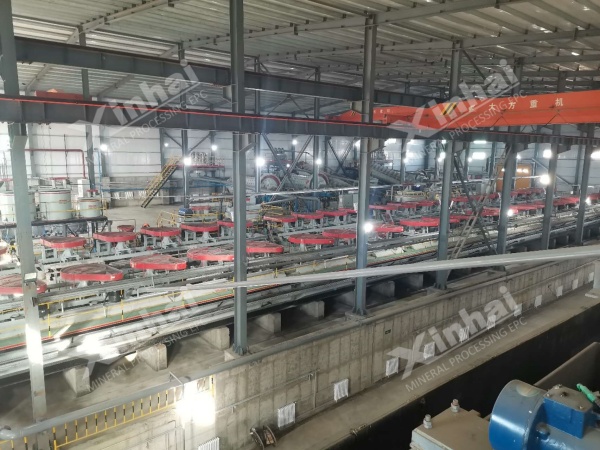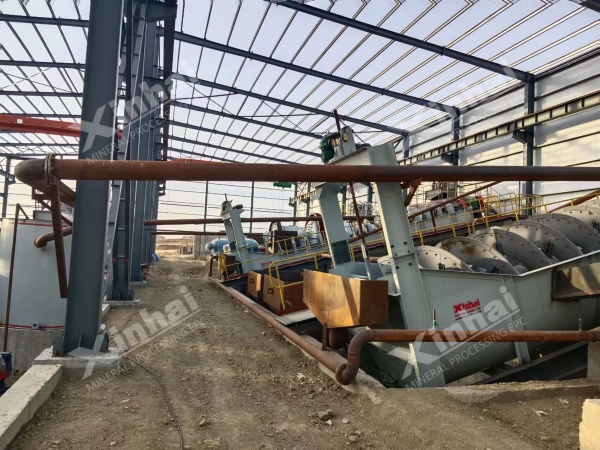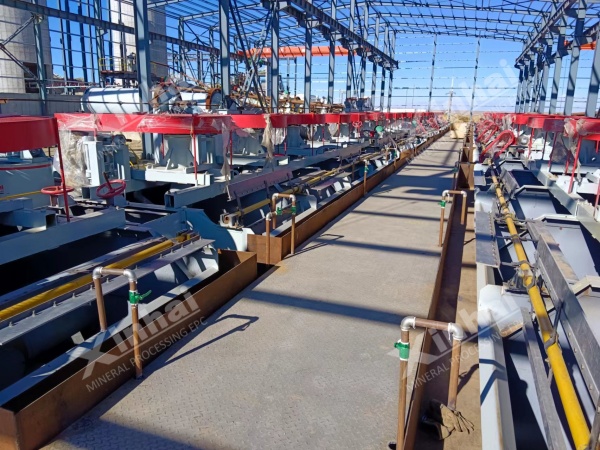If you want to know more information (such as product/process price, etc.), please contact us 24-hour telephone
Calcite-associated fluorite ore mainly consists of calcite (CaCO₃) and fluorite (CaF₂), with associated minerals including quartz, barite, sulfides, and trace amounts of rare earth elements. The primary beneficiation method for this type of ore is flotation. However, due to the similar physical and chemical properties of calcite and fluorite—both being calcium-bearing minerals—their separation via flotation presents significant challenges. This article provides a detailed explanation of the separation process.
Calcite-associated fluorite deposits are found in many countries around the world, including China, Mexico, the United States, Spain, the United Kingdom, Morocco, and South Africa. Among these, Mexico is known for its large fluorite–calcite vein-type deposits.

Pulp pH Value
The separation of calcite and fluorite is a complex process. First, the pulp pH should be adjusted to the range of 8.0–9.5. In this range, both calcite and fluorite can be floated, but under acidic conditions, the floatability of calcite is lower than that of fluorite.
Collector Selection
Fatty acid collectors are commonly used in the flotation separation of calcite and fluorite. Typical collectors include oleic acid and oxidized paraffin soap. These collectors enable both calcite and fluorite to float simultaneously, but their differences in floatability must be further regulated.
Depressant Selection
Commonly used depressants in the flotation of calcite-associated fluorite ores include sodium silicate (water glass), modified sodium silicate (acidified or salted), sodium hexametaphosphate, lignosulfonates, dextrins, tannins, and tannin extracts. These reagents exhibit varying degrees of selectivity and effectiveness:
Sodium silicate: A widely used depressant, particularly effective against silicate gangue minerals such as quartz. However, its depressing effect on calcite and fluorite is relatively limited.
Acidified sodium silicate: Provides improved selectivity for depressing either fluorite or calcite, depending on pH and reagent dosage.
Sodium hexametaphosphate: A phosphate-based depressant that exhibits strong suppression of calcite, while exerting minimal influence on fluorite flotation.
Lignosulfonates, dextrins, tannins, and tannin extracts: These organic depressants can be applied individually or synergistically to enhance the selective depression of either calcite or fluorite, depending on the specific flotation conditions.

Crushing and Screening
Jaw crushers, cone crushers, and vibrating screens are typically used to complete the crushing and screening stages. The ore is usually crushed in two or three stages to achieve a particle size of 1–5 mm.
Grinding and Classification
Ball mills in combination with classifiers or hydrocyclones are used for grinding and classification. Two or three stages of grinding are commonly employed: a grid-type ball mill for coarse grinding and an overflow ball mill for fine grinding. After grinding, the ore is typically -200 mesh, accounting for 50% to 90%.
Flotation
Roughing: Fatty acid collectors are used in the roughing stage to initially separate fluorite from calcite.
Cleaning: In the cleaning stage, depressants are added to suppress calcite and enhance fluorite concentrate grade.
Multiple Cleaning Stages: Several stages of cleaning are generally required to meet the grade specifications for fluorite concentrate.
Concentration and Dewatering
A thickener is used to increase the pulp density to 50%–60%. Subsequently, a vacuum filter or filter press is employed to further dewater the concentrate to a moisture content below 10%, yielding marketable fluorite concentrate.
Tailings Treatment
After dewatering, tailings are dried to reduce moisture content. The dry tailings can be repurposed for construction materials or used as mine backfill. Dry stacking not only reduces land occupation compared to conventional wet tailings disposal but also improves safety by preventing dam failures. Additionally, this method helps remove residual reagents and mitigates environmental pollution.

Process Flow:
In a calcite-associated fluorite ore beneficiation project in Zhejiang, water glass was initially used as a depressant to pre-remove calcium carbonate. Subsequently, oxidized paraffin soap was applied as a collector, while acidified water glass and ATM were used as depressants. The flotation process included seven stages of cleaning to effectively separate fluorite from calcite.
Project Results:
After seven stages of cleaning, a fluorite concentrate with a CaF₂ grade of 93.95% and a recovery rate of 24.15% was obtained. On average, the fluorite concentrate grade was 90.52%, and the average recovery rate was 21.82%.
Conclusion
The main challenge in the flotation separation of calcite-associated fluorite ore lies in the similar physical and chemical properties of fluorite and calcite, which makes them difficult to separate using conventional flotation methods. It is essential to modify surface properties through selective collectors and depressants to achieve effective separation.
With over 30 years of experience, Xinhai Mining has undertaken hundreds of fluorite beneficiation projects and accumulated extensive expertise in fluorite flotation. Our professional team can provide comprehensive services ranging from mineral processing tests and process design to equipment selection and project operation. If you need solutions for calcite-associated fluorite ore processing, feel free to contact us.